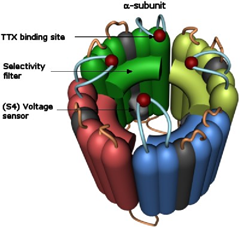In the following chapters, we will focus our attention on an important case of a beneficial allele: the resistance gene from the mosquito Anopheles gambiae, which is the primary vector of the causative agent of malaria, Plasmodium. This gene is called kdr ,an acronym for knock down resistance. The kdr gene codes for a voltage dependent sodium channel in the neuronal cells of the insect. Upon activation, this channel allows an influx of sodium across the membrane of the cell and is responsible for the rapid electric signaling of the neurons. A correct functioning of the receptor is essential for nervous system to work properly.

The sodium channel is also the main target of the DDT and other insecticides. DDT is a simple chemical compound (the structure is shown in figure 2) that binds to the sodium channel and disturbs its function as it permanently opens the channel. The consequence is the paralization and death of the animal. There are two different alleles coding for the sodium channel. One allele of the kdr gene which we call kdr_mut differs from the wildtype (normal) kdr_wt in a single point mutation like the mutation example number 2 on the previous page. Due to the mutation of one amino acid, which does not affect the normal function of the channel, DDT cannot bind anymore and exert its function, making the animal resistant to DDT and similar insecticides. For this reason the gene was called knock down resistance. Before the usage of DDT the two alleles were neutral[G] because none of them provides any advantage or disadvantage. But in the large scale DDT treatment the kdr_mut allele became beneficial as only mosquitoes with that allele survived.

With this intro you have everything you need to understand the sections 2 and 3. So let's go.
